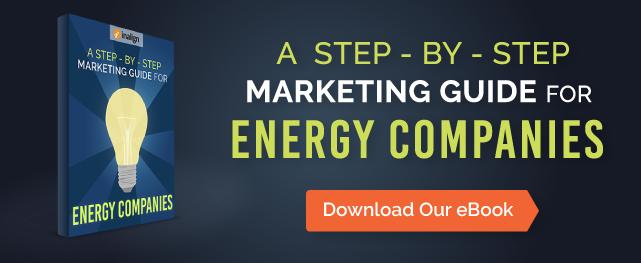Successful retail energy marketing begins with knowing who you want to reach with your marketing efforts.
While it’s tempting to think that your potential prospects are every homeowner and business in your marketing territory that uses electricity and/or natural gas, your REAL potential prospects are likely a much smaller group of users who are open to switching suppliers and are looking for solutions that your company can best provide.
Who are the best prospects for your energy service company? They are people with problems and pain points similar to the people you would consider to be your ideal customers or buyers of electricity and natural gas.
Think about your best commercial or residential electric customers. What makes them an “ideal customer” for you? What problems did they have that you solved for them and turned them into a long-lasting customer of yours?
Now think about your best commercial or residential natural gas customers. Are they different from your best commercial electric customers or are they the same? What problems do you solve for them?
By defining who your ideal customers are (i.e., your buyer personas), and creating content and messaging that appeals to them, you are much more likely to attract prospects to your website who will become leads, customers and promoters of your brand and company.
What is a Buyer Persona?
Understanding your ideal customers requires more than just knowing their demographics. It requires an understanding about their needs, interests, concerns and where they can be reached online (e.g., social media, blogs, search engines).
HubSpot provides one of the best definitions: buyer personas are "semi-fictional representations of your ideal customers based on real data and some select educated speculation about customer demographics, behavior patterns, motivations and goals."
Here are some of the important takeaways from this definition:
- Buyer personas are "semi-fictional." They are not profiles of actual customers.
- Buyer personas are based on "real data" and "educated speculation." They are developed by conducting interviews or surveys of your current customers, and by talking to your sales force.
- Buyer personas inform us about common behavior patterns, shared pain points and motivations, universal goals and general demographics of your ideal customers. They are not target markets.
Why is it Important to Define Your Company’s Buyer Personas?
Three reasons:
- It will help your sales and marketing teams to decide where it is best to spend their time, resources and efforts.
- It makes it easier for you to create the right content for your website and social sites and to know where best to promote it.
- It ensures that your sales and marketing teams are aligned and in agreement with whom they should be focusing on as the best opportunities to become your customers.
How are Buyer Persona Profiles Created?
Profiles of ideal customers (i.e., buyer personas) are usually created through a combination of in-depth interviews with your marketing and sales team and by conducting extensive interviews with customers you consider to be your company’s ideal customers. These personas are fictional representations of your ideal customers.
Most energy service companies will have between two and four buyer personas.
Here are some of the questions that should be answered to create a profile for a commercial retail energy buyer persona:
- What is their demographic information?
- Male or female?
- Age range?
- Income range?
- Geographic location?
- Family?
- What is their job and level of seniority?
- What industry do they work in?
- What is their job title?
- Are they an owner, manager, director?
- What is the size of the company they work for (sales, employees)?
- How long have they been in their position?
- How long have they been with the company?
- Who do they report to? Who reports to them?
- What are they responsible for?
- What does it mean to be successful in their role?
- Do they make purchasing decisions or do they need to involve others in purchasing decisions?
- What does a day in their life look like?
- What does a typical workday look like for them?
- What are their hobbies, interest?
- What are their pain points? What do you help them solve?
- What is motivating them to consider changing energy suppliers?
- What worries them most about changing energy suppliers?
- What do they want most from a new energy supplier?
- Are they price sensitive?
- What do they value most? What are their goals?
- What would make them really, really excited about working with your company?
- What don’t they care about?
- Where do they go for information?
- What kind of information do they tend to consume online? Do they read blogs? Do they watch videos? Do they use interactive tools such as calculators?
- Are they active on LinkedIn or other social networks? What forums do they participate in?
- What kind of search terms do they use to find out about energy suppliers?
- Which of your products do they spend the most time researching?
- What experience are they looking for when seeking out your products or services?
- What should their sales experience feel like?
- How much time do they expect to spend with a consultant?
- What are their most common objections to your product or service?
- Is this their first time buying natural gas or electricity from a supplier other than a utility?
- If not, what kind of experience have they had with other energy services companies?
- What might give them concern about buying from your company?
Example: A Commercial Retail Energy Buyer Persona
By answering the questions above you can create a commercial electricity and natural gas buyer persona, might look something like this:
 Name: Small Business Sam
Name: Small Business Sam
Position: Sam owns a successful small manufacturing business.
Company Info: Sam started the company 20 years ago after a successful career as a mechanical engineer for a large company. His company has 15 full-time employees and $5M annual revenues.
Demographic and Day-to-Day Info: Sam is a Syracuse native and college grad, as is his wife. He is in his mid-50s and enjoys entertaining family, friends and business associates. Sam travels a good deal on his job and is known for his sense of humor, self-confidence and competitiveness. He competes in a couple of triathlons each year.
Where He Gets Information: Sam is well networked in the business community. He has a few close friends he relies on for recommendations. He reads a few business trade journals and industry blogs. He spends a lot of time on his computer both at work and home. He has business and personal email accounts that he uses regularly. He also enjoys using his smartphone. He has a LinkedIn account. He’s not on Facebook or Twitter.
What He Values Most: Sam is a risk taker and is open to trying new things. He values business partners who are also risk takers and bring him new ideas.
Pain Points and Challenges: Sam is concerned about the rising cost of employee benefits and the inability to increase his prices due to competition. He is looking for other solutions to reduce operating expenses. Energy costs are a large part of his budget. He buys natural gas and electricity from his local utility and feels like he has no control over this part of his operating costs. He acknowledges that he doesn’t know much about energy pricing and energy efficiency options. He would be interested in talking to someone he could trust.
Common Objections to Energy Services Companies: Sam has heard stories about energy services companies that promised lower prices than the utility company but they actually charged more. He’s not sure whom to trust.
Conclusion
Determining who you want to reach is an often overlooked but critical first step to attracting the right prospects to your website and brand. Not every user of electricity and natural gas in your market is a good fit for your company and brand. By defining your buyer personas and creating content that appeals to them, you will be much more successful in attracting the right prospects and building a sales funnel of good, qualified leads.








